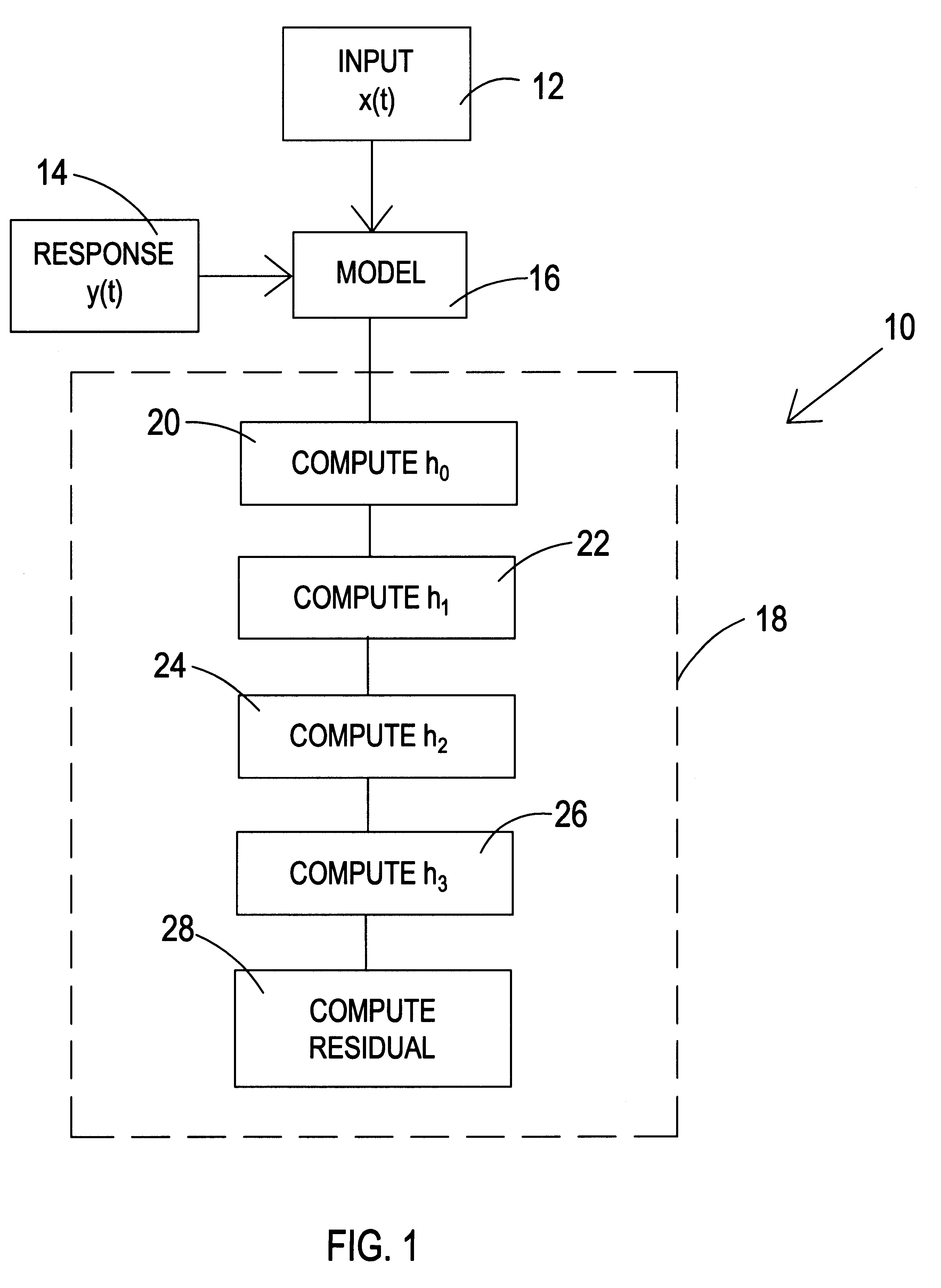Method and apparatus for active sonar detection enhancement
a technology of active sonar and enhancement, applied in the field of active sonar system systems, can solve the problems of inability to accurately measure and inability to accurately estimate what happens between excitation input and output, and relatively high transmission loss of active sonar signals. , the effect of increasing the transmission loss
- Summary
- Abstract
- Description
- Claims
- Application Information
AI Technical Summary
Benefits of technology
Problems solved by technology
Method used
Image
Examples
case i
If x(t)=0 for all t then:
y(t)=h.sub.0. (8)
This allows for explicit determination of h.sub.0 as indicated at 20 in FIG. 1 within nonlinear processor 18.
case ii
Let excitation x(t) be real white Gaussian noise of spectral level, .rho. watts / Hz, and y(t) is the observed response.
Consider cross-correlation, C(.tau..sub.a).ident.(y(t).times.(t-.tau..sub.a)). The overbar is an ensemble average over many realizations. In actual use, an acceptable practice is to take the sample mean in place of the ensemble mean.
y(t).times.(t-.tau..sub.a)
=.rho.h.sub.1 (.tau..sub.a)+
.rho..sup.2.intg..intg..intg.d.tau..sub.1 d.tau..sub.2 d.tau..sub.3 (.tau.
.sub.1,.tau..sub.2,.tau..sub.3)[.delta.(.tau..sub.1 -
.tau..sub.2).delta.(.tau..sub.a -.tau..sub.3)+.delta.(.tau..sub.1 -
.tau..sub.3).delta.(.tau..sub.a -.tau..sub.2)+
.delta.(.tau..sub.a -.tau..sub.1).delta.(.tau..sub.2 -
.tau..sub.3)]=.rho.h.sub.1 (.tau..sub.a)+
3.rho..sup.2.intg.d.tau..sub.1 h.sub.3 (.tau..sub.1,.tau.
.sub.2,.tau..sub.a). (9)
If the system is only second-order, the last term on the right-hand side of equation (9) is zero and the equation is reduced accordingly.
case iii
The higher order correlation where .tau..sub.a.noteq..tau..sub.b is obtained as follows:
y(t).times.(t-.tau..sub.a).times.(t-.tau..sub.b)=
h.sub.0.rho..delta.(.tau..sub.a -.tau..sub.b)+.rho..sup.2.intg.
.intg.d.tau..sub.1 d.tau..sub.2 h.sub.2 (.tau..sub.1,.tau..sub.2)[
.delta.(.tau..sub.1 -.tau..sub.2).delta.(.tau..sub.a -.tau..sub.b)+
.delta.(.tau..sub.1 -.tau..sub.a).delta.(.tau..sub.2 -.tau..sub.b)+
.delta.(.tau..sub.1 -.tau..sub.b).delta.(.tau..sub.2 -.tau..sub.a)]
=h.sub.0.rho..delta.(.tau..sub.a -.tau..sub.b)+
.rho..sup.2 [.delta.(.tau..sub.a -.tau..sub.b).intg.d.tau..sub.1 h.sub.2 (.tau..sub.1,.tau..sub.1)+
2h.sub.2 (.tau..sub.a,.tau..sub.b)]
=[h.sub.0 +.rho..intg.d.tau..sub.1 h.sub.2 (.tau..sub.1,.tau..sub.1)].rho..delta.(.tau..sub.a -.tau..sub.b)+
2.rho..sup.2 h.sub.2 (.tau..sub.a,.tau..sub.b)=
y(t).rho..delta.(.tau..sub.a -.tau..sub.b)+2.rho..sup.2 h.sub.2 (.tau..sub.a,.tau..sub.b). (10)
This allows for determination of h.sub.2 (.tau..sub.a,.tau..sub.b) at any .tau..sub.a,.tau..sub.b p...
PUM
 Login to View More
Login to View More Abstract
Description
Claims
Application Information
 Login to View More
Login to View More - R&D
- Intellectual Property
- Life Sciences
- Materials
- Tech Scout
- Unparalleled Data Quality
- Higher Quality Content
- 60% Fewer Hallucinations
Browse by: Latest US Patents, China's latest patents, Technical Efficacy Thesaurus, Application Domain, Technology Topic, Popular Technical Reports.
© 2025 PatSnap. All rights reserved.Legal|Privacy policy|Modern Slavery Act Transparency Statement|Sitemap|About US| Contact US: help@patsnap.com



